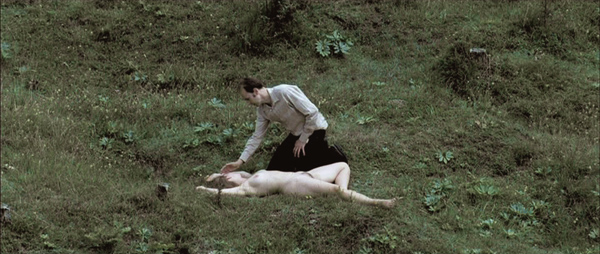Film / Video, 2008
aufgenommen auf 35 mm Negativ, verfügbar als HD-CAM, DigiBeta und Bluray, Farbe, Ton 10 min (Filmversion oder Loop) Format: 16:9 Sprache: Deutsch oder Englisch
Der Text basiert auf dem Buch „Theorie des kommunikativen Handelns“ von Jürgen Habermas
Synopsis
In einer Welt ist die Welt eine idyllische Gebirgslandschaft mit Wäldern und Wiesen. Durch diese schreitet ein Mann, allein. In der folgenden Einstellung steht er auf einer Wiese, in deren hohem Gras ein Dutzend nackter Frauen liegt; jede einzelne drapiert, wie von einem Maler gezeichnet. Der Mann, dessen Unsicherheit und Einsamkeit förmlich zu spüren ist, nähert sich den Frauen, einer nach der anderen, in liebkosenden und erotischen Annäherungen, mal zärtlich, mal direkt. Seine Kontaktversuche bleiben jedoch unerwidert, erzeugen keinerlei Regung. Die Frauen scheinen Teil der Natur geworden zu sein, ganz wie „von einer anderen Welt“. Es folgt ein weiter Blick in die Landschaft, diesmal begleitet von Textpassagen aus Jürgen Habermas’ Theorie des kommunikativen Handelns (1981), die am unteren Bildrand zu lesen sind. Die Exzerpte zur „kommunikativen Rationalität“ verschieben das sinnliche Bild in eine abstrakte Dimension und liefern der Arbeit zudem ihren Titel. Mit minimalen Mitteln der Inszenierung eröffnet die Künstlerin einen Diskurs über Formen der Sprachlosigkeit zwischen den Geschlechtern, zwischen Körper und Geist, zwischen dem Emotionalen und dem Rationalen, zwischen Natur und Kultur, zwischen der einen Welt und der anderen. Anke Hoffmann
Weitere Informationen
mit Piet Fuchs Claudia Antl Susan Florries Eva Heitzinger Barbara Anna Husar Raluca Jacono- Muntean Marianne Lang Martina Lunzer Anne Mueck Amanda Sheely Elisabeth StreitRegie Corinna Schnitt
Assistenz Carolin Schmitz
Kamera Volkmar Geiblinger
Assistenz Thea Adlung
Produktionsmanager Martin Åström
Assistenz Michael Aicher
Ton Peter Utvary
Maske Stefanie Lamm
Entstanden im Rahmen „Edition Bewegte Bilder“
Produziert mit freundlicher Unterstützung: Sammlung Rheingold GbR In Zusammenarbeit:
Museum Ludwig, Köln Danke Artist-in-Residence-Programm „ORTung“ in Strobl und den Besitzern der Moosalm, Österreich Barbara Engelbach, Georg Elben, Sammlung Rheingold und Museum Ludwig, Köln
Text
Der Begriff der kommunikativen Rationalität bedarf einer genaueren Explikation. Zunächst können wir festhalten, daß der Begriff der kommunikativen Rationalität am Leitfaden sprachlicher Verständigung analysiert werden muß. Der Begriff der Verständigung verweist auf ein unter Beteiligten erzieltes rational motiviertes Einverständnis, das sich an kritisierbaren Geltungsansprüchen bemißt. Die Geltungsansprüche (propositionale Wahrheit, normative Richtigkeit und subjektive Wahrhaftigkeit) kennzeichnen verschiedene Kategorien eines Wissens, das in Äußerungen symbolisch verkörpert wird. Diese Äußerungen können näher analysiert werden, und zwar einerseits unter dem Aspekt, wie solche Äußerungen begründet werden können, andererseits unter dem Aspekt, wie sich Akteure mit ihnen auf etwas in einer Welt beziehen.Die Welt gilt als die Gesamtheit dessen, was der Fall ist; und was der Fall ist, kann in Form wahrer Aussagen festgestellt werden. Ausgehend von diesem allgemeinen Konzept von Welt lassen sich die Begriffe der ersten, zweiten und dritten Welt spezifizieren. Die Entitäten haben je nach ihrer Zugehörigkeit zu einer der drei Welten eine spezifische Seinsweise: es handelt sich um physische Gegenstände und Ereignisse; um mentale Zustände und innere Episoden; um die Bedeutungsgehalte symbolischer Gebilde. Die symbolischen Gebilde werden zwar durch den produktiven menschlichen Geist erzeugt; obschon selber Produkte, treten sie dem subjektiven Geist mit der Objektivität eines spröden, problematischen, undurchschauten, durch intellektuelle Arbeit erst aufzuschließenden Sinnzusammenhang entgegen. Die Produkte des menschlichen Geistes kehren sich unverzüglich als Probleme gegen ihn: Diese Probleme sind offensichtlich selbständig. Sie werden in keiner Weise von uns geschaffen; vielmehr entdecken wir sie, und in diesem Sinne existieren sie schon vor ihrer Entdeckung. Darüber hinaus sind mindestens einige dieser Probleme möglicherweise unlösbar. Um diese Probleme zu lösen, erfinden wir vielleicht neue Theorien. Wenn wir aber diese Theorien einmal geschaffen haben, dann erzeugen sie neue, unbeabsichtigte und unerwartete Probleme, die entdeckt werden müssen.
About a world
Film / Video, 2008
shot on 35 mm Negativ, available on HD-CAM, DigiBeta and Bluray, colour, sound 10 min (Filmversion or Loop) Format: 16:9 Language: German or English
The text is based on the book “Theory of Communicative Action” by Jürgen Habermas
Synopsis
In “Von einer Welt” [“FromOne World”], Corinna Schnitt’s latest work, the world is an idyllic Alpine landscape of forests and meadows. A man is striding through it, alone, to stand in the next scene on a meadow with a dozen nude women lying in high grass; each is draped as they would be if drawn from life by a painter. The man, whose uncertainty and loneliness are palpable, approaches each woman individually, one after the other, caressing and making erotic overtures, at times tenderly, at others more overtly. His attempts at making contact remain futile, however, as they produce no reaction at all. The women seem to have become part of nature, as if “from another world”. Again a long shot of the scenery appears, this time with passages fromJürgen Habermas’ The Theory of Communicative Action, which can be read on the lower edge of the picture. The excerpts dealing with “communicative rationality” shift the sensory/sensual image to an abstract plane while also providing the work with its title. With minimalist staging devices, the artist opens a discourse on the forms of aphasia between the sexes, between body and intellect, between the emotional and the rational, between nature and culture, between one world and another.
Anke Hoffmann
More Information
The concept of communicative rationality is in need of a more precise explication. We can begin with the claim that the concept of communicative rationality has to be analyzed in connection with achieving understanding in language. The concept of reaching understanding suggests a rationally motivated agreement among participants that is measured against criticizable validity claims. The validity claims (propositional truth, normative rightness, and subjective truthfulness) characterize different categories of a knowledge embodied in symbolic expressions. These expressions can be more closely analyzed in two ways- with respect to how they can be defended and with respect to how actors relate through them to something in a world.The world counts as the totality of what is the case; and what is the case can be stated in the form of true propositions. Starting from this general concept of the world, we can specify the concepts of the first, second and third worlds by the way in which states of affairs exist. The entities belonging to each of these three worlds have a specific mode of being: physical objects and events, mental states and episodes, and semantic contents of symbolic formations. Symbolic formations are, it is true, generated by the productive human mind; but though they are themselves products, they confront subjective mind with the objectivity of a problematic, uncomprehended complex of meaning that can be opened up only through intellectual labor. The products of the human mind immediately turn against it as problems. These problems are clearly autonomous. They are in no sense made by us; rather, they are discovered by us; and in this sense they exist, undiscovered, before their discovery. Moreover, at least some of these unsolved problems may be insoluble. In our attempts to solve these or other problems we may invent new theories. Yet the moment we have produced these theories, they create new, unintended and unexpected problems, autonomous problems, problems to be discovered.
Text
The concept of communicative rationality is in need of a more precise explication. We can begin with the claim that the concept of communicative rationality has to be analyzed in connection with achieving understanding in language. The concept of reaching understanding suggests a rationally motivated agreement among participants that is measured against criticizable validity claims. The validity claims (propositional truth, normative rightness, and subjective truthfulness) characterize different categories of a knowledge embodied in symbolic expressions. These expressions can be more closely analyzed in two ways- with respect to how they can be defended and with respect to how actors relate through them to something in a world.The world counts as the totality of what is the case; and what is the case can be stated in the form of true propositions. Starting from this general concept of the world, we can specify the concepts of the first, second and third worlds by the way in which states of affairs exist. The entities belonging to each of these three worlds have a specific mode of being: physical objects and events, mental states and episodes, and semantic contents of symbolic formations. Symbolic formations are, it is true, generated by the productive human mind; but though they are themselves products, they confront subjective mind with the objectivity of a problematic, uncomprehended complex of meaning that can be opened up only through intellectual labor. The products of the human mind immediately turn against it as problems. These problems are clearly autonomous. They are in no sense made by us; rather, they are discovered by us; and in this sense they exist, undiscovered, before their discovery. Moreover, at least some of these unsolved problems may be insoluble. In our attempts to solve these or other problems we may invent new theories. Yet the moment we have produced these theories, they create new, unintended and unexpected problems, autonomous problems, problems to be discovered.



